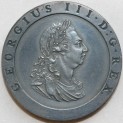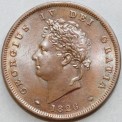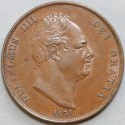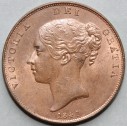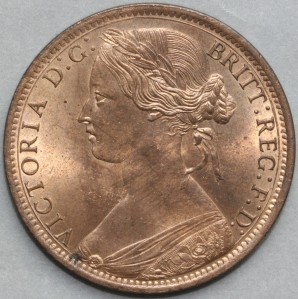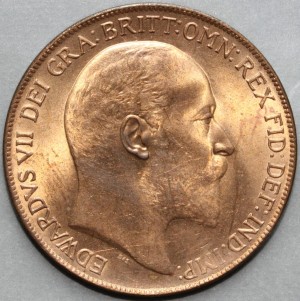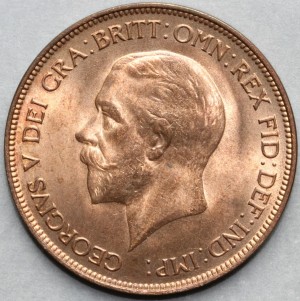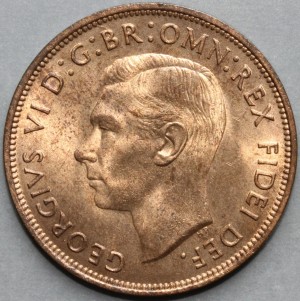|
|
|
|
|
|
|
|
|
|
|
The purpose of this site is to provide illustrations and descriptions of all the major varieties of Obverse and Reverse designs used on the milled copper and bronze pennies issued from 1797 to 1970 inclusive, to assist fellow collectors in the identification of coins.
For copper coins, there are no universally used naming conventions for obverse and reverse designs and so I have applied my own, using numbers for obverses and capital letters for reverses.
For bronze coins I have used the naming conventions defined and used by the eminent numismatic experts Michael Freeman and Michael Gouby.
There will always be an ongoing debate around the definition of “variety”. For the purposes of this website I regard a basic “variety” as being a unique combination of date, obverse design and reverse design. When further variations occur through the accidental amendment of a working die, either by human intervention (such as the botched repair of a date numeral or legend character) or through the striking process (such as the raised dots often encountered), I refer to these as “sub-varieties”. For variety reference purposes, I use the Peck number and/or Bramah reference for copper coins, and for bronze coins the Freeman number (as defined in his book “The Bronze Coinage of Great Britain”) and/or Gouby’s naming convention, a code comprising BP (Bronze Penny), Year (NNNN), plus unique alphanumeric suffix denoting the variety. Thus, the first official bronze currency coin of 1860 is defined as F1 by Freeman and BP1860D by Gouby. I have attempted to pull together a comprehensive list of the various varieties of bronze currency and proof pennies into a single source, together with their Gouby and Freeman identifiers, and have listed them for each monarch on pages following the various obverses and reverses.
For further information on these designs and naming conventions, please refer to the seminal publications listed below.
The pictures used on this website are either taken from auction house websites which put their photographs in the public domain or supplied by coin collectors with their express permission. I am grateful to both sources.
Important – over-strikes occur regularly on coins, i.e. a letter or number is struck over another letter or number. I do not consider that a double (or triple) strike, i.e. where a letter or number has been over-struck with itself, represents a genuine recordable variety. However, when a letter or number has been over-struck by a different letter or number either deliberately or accidentally (usually in a botched repair) such as the 1865 over 3 penny, where the 5 is clearly over 3, this is generally considered to be a genuine recordable and collectable variety. I have included such over-strikes within this website.
I have also not attempted to list all the minor date width variations that occur throughout the copper and bronze series. However, it is important to understand how Michael Gouby defines date widths when identifying a particular date variation and so I have described this on a separate website page (Gouby Date Widths)
Rarity
I have included Gouby’s and Peck’s codes for rarity for bronze and copper coins respectively, and Freeman’s codes for the rare bronze patterns. They are as follows:
Gouby
A1 – Abundant C2 – Common N3 – Normal S4 – Scarce (201-500) R5 – Rare (101-200) R6 Very Rare (51-100) R7 – Extremely Rare (26-50) R8 – 10 to 25 possibly known R9 – 2 to 9 possibly known PU – possibly unique
Where Gouby quotes a known population, I have quoted this absolute number rather than one of the above codes
Peck
EXC – excessively common EC – extremely common VC – very common C – common S – scarce VS – very scarce R – rare VR – very rare ER – extremely rare EXR – excessively rare PU – probably unique
Freeman (rarest codes only)
R20 – believed unique R19 – 2 to 5 specimens R18 – 6 to 15 R17 – 16 to 50
R16 – 51 to 100 R15 – 101 to 250 R14 – 251 to 500 R13 – 501 to 1000
Publications:
- English, Copper, Tin and Bronze Coins in the British Museum 1558 – 1958 by Wilson C Peck
- The Bronze Coinage of Great Britain by Michael Freeman
- The British Bronze Penny by Michael Gouby
- The British Bronze Penny (Victoria 1860 – 1901) by Michael Gouby
- English Regal Copper Coins by Ernest Bramah
- The Early British Bronze “Bun” Pennies 1860 to 1865 by John Jerrams
- The Identification of British 20th Century Bronze Coin Varieties by David J. Groom
I hope you enjoy this site and that it helps you learn more about the fascinating subject of Numismatics and, in particular, about English pre-decimal pennies. I will always be delighted to learn about newly discovered varieties not mentioned on this website.
Richard Sessions (rasessions@aol.com)
